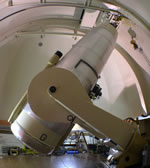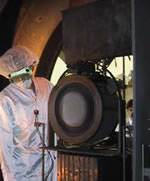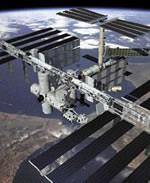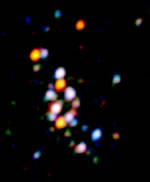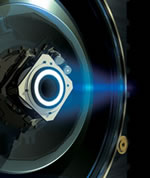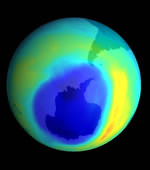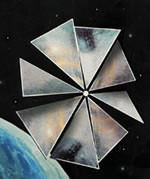
Image credit: Planetary Society
A full-sized replica of a Cosmos 1 solar sail is now on display at the Rockefeller Center “Centennial of Flight” exhibit in New York City. The 14.3 metre blade is made of a silvery Mylar-like material and joins several other exhibits at the show. If all goes well, the real solar sail will be launched on board a refurbished Russian ICBM some time this fall. The sail will be on display until August 18, 2003.
Planetary Society and Cosmos Studios will unfold a replica of one of the eight 47-foot blades that make up the Cosmos 1 Solar Sail spacecraft, which is slated to launch later this year. The silvery mylar-like blade will be on display in New York City as part of a large Rockefeller Center “Centennial of Flight” exhibit. The exhibit is from July 29 – August 18. Suspended from the soaring lobby ceiling, the blade will give the public their first-ever opportunity to see a technology that will likely fly missions throughout the solar system and to the stars.
A joint venture of The Planetary Society and Cosmos Studios, the Cosmos 1 Solar Sail is a visionary approach to space exploration. This is the first space mission ever conducted by a space interest group, and also the first by an entertainment media company.
“During the early 20th Century humanity found its wings above the sands of Kitty Hawk. Cosmos 1 represents the next centennial of flight, which will take us and our robotic emissaries from Earth to Mars, Pluto and beyond,” said Dr. Louis Friedman, Cosmos 1 Project Director and Executive Director of The Planetary Society.
“That a century after the Wright Bros.’ first flight, it is still possible for a small group of people with modest means to reach for the stars, is a good sign that the American dream remains vibrant,” said Ann Druyan, Cosmos 1 Program Director and CEO of Cosmos Studios. “Our launch vehicle, a Russian ICBM, has been converted from a weapon of mass destruction into a means of advancing the dream of exploring the universe. In this way, we hope to honor the inspiration of Carl Sagan and to give our kids a critically needed vision of a hopeful future.”
Solar sailing utilizes reflected light pressure pushing on giant panels, which adjust to the continuously changing orbital energy and spacecraft velocity. The sunlight pressure is powerful enough to push spacecraft between the planets. Beyond the solar system, space sailing can be done using powerful lasers focused over long distances in space. Solar sails might help us realize the long-sought dream of interstellar flight.
Other exhibits at the Centennial of Flight Anniversary will include a full-scale model of the Redstone Mercury rocket, a replica of Apollo 13, a model of the Wright Flyer, an X-43C (NASA’s prototype of the SCRAM JET engine), among other exhibits.
Cosmos 1 Solar Sail is a privately funded project with scientific and commercial applications that involve the cooperation of Russian space and defense organizations through a contract with The Planetary Society. The sail blade model being exhibited in part was developed by the Babakin Space Center near Moscow, Russia.
Babakin Space Center is the prime contractor for Cosmos 1. Babakin is a spin-off organization of NPO Lavochkin, one of the largest manufacturers of robotic spacecraft in the world. The Space Research Institute of the Russian Academy of Sciences and Makeev Rocket Design Bureau also play major roles in project development. Makeev is responsible for development of the Volna rocket – which will launch Cosmos 1 – and has made arrangements with the Russian Navy for the launch.
Original Source: Planetary Society News Release

